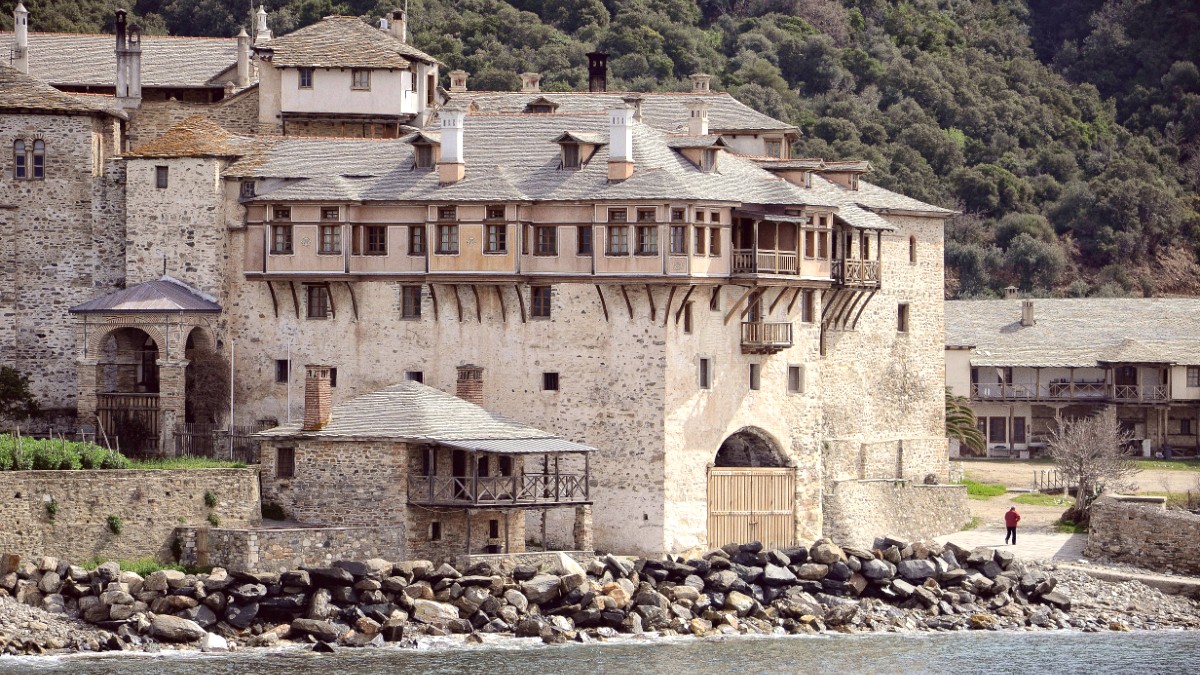
Greece
The 20 Sovereign Monasteries of Mount Athos are the premier landmarks, each possessing unique architectural and spiritual significance.
From the first-founded Megisti Lavra to the cliff-perched Simonopetra, each monastic complex presents a journey through centuries of Orthodox history and art.
For photography, seek outdoor shots of monastery exteriors and landscapes. Early morning light often provides the best conditions.
Every monastery and skete on the Holy Mountain represents a living historical site, demonstrating centuries of architectural evolution and uninterrupted monastic practice.
The network of ancient cobblestone paths and dirt trails connecting monasteries are historical routes, walked by pilgrims for over a thousand years.
Each coastal monastery possesses an "arsenas" (boathouse). Many of these structures are historical, reflecting centuries of maritime activity and reliance on sea transport.
The principal church of the Holy Community, featuring exquisite 14th-century frescoes by Manuel Panselinos.
The summit itself holds historical significance for spiritual ascents.
Beyond its spiritual heritage, Mount Athos extends stunning natural beauty, a backdrop for profound contemplation.
The highest point on the peninsula. It grants panoramic views of the entire peninsula and the surrounding Aegean Sea on clear days.
The peninsula boasts dramatic cliffs, secluded coves, and clear Aegean waters. The coastline remains largely untouched.
Lush, ancient forests cover much of the peninsula, preserving unique biodiversity. They constitute one of the last large natural forests in Greece.
Mount Athos is home to diverse bird species, wild boars, and other animals. You might encounter wildlife while hiking, especially in quieter areas.
Small, secluded pebble beaches exist along the coast, mainly for monastic use. No significant lakes are present.
The absence of commercial tourism preserves the natural landscapes in their untouched state, contributing to an unique atmosphere.
A small, almost hidden settlement of cells high on the slopes of Mount Athos. It extends breathtaking views and a profound sense of solitude. Access needs a challenging hike.
A small chapel near the summit of Mount Athos. This refuge often serves as a common overnight stop for pilgrims ascending the peak, giving basic shelter before the final climb.
Scattered throughout the wilderness, these dwellings give a glimpse into the most ascetic forms of Athonite monasticism. Karoulia and Katounakia. Access is challenging.
The "attractions" of Mount Athos reside in its living traditions, its sacred spaces, and the profound peace found within its ancient walls and natural landscapes. Approach your visit as a pilgrimage for spiritual and historical depth.
Unlike typical tourist destinations, Mount Athos does not operate commercial tours or attraction bookings. Entry is controlled by the Diamonitirion, and access to monasteries depends on their capacity and the pilgrim's respectful conduct.
Affiliate resources for general attraction tickets (like GetYourGuide) are not directly applicable for entry Into Mount Athos, but might be useful for activities Outside the Holy Mountain in the wider region.
Your Diamonitirion is the sole pass for entry to Mount Athos and its monasteries.
Mount Athos is a self-governed monastic state. It does not have commercial tour operators or ticketed attractions in the typical sense.
While Mount Athos operates uniquely, you may find these platforms useful for other attractions in Greece before or after your pilgrimage:
Prepare for a deeply spiritual and physically engaging experience, not a conventional sightseeing tour.
Beyond the main monasteries and the peak, Mount Athos contains hidden gems and natural wonders that enhance the pilgrimage experience.
These small, isolated communities offer a glimpse into the most ascetic forms of monastic life. They provide deep spiritual solitude and immersion in pristine nature.
The largely untouched coastline of Mount Athos presents dramatic cliffs, secluded coves, and clear Aegean waters, reserved mainly for monastic transport and fishing.
Lush, ancient forests cover much of the peninsula, preserving unique biodiversity and granting a tranquil environment for walking. They represent one of Greece's last large natural forests.
A large monastery with distinctive onion domes, historically housing a vast community of Russian monks.
Explore Greece with GetYourGuideA monastery with deep historical and spiritual ties to Serbia, preserving a rich collection of Serbian icons and manuscripts.
Discover Greek Cultural ExperiencesServes as a spiritual home for Bulgarian Orthodox pilgrims and possesses a long and storied history.
Browse Historical Tours in GreeceAnother impressive cliffside monastery that presents breathtaking views and houses important relics.
Plan Your Trip with GetYourGuideHouses the miraculous Panagia Portaitissa icon, drawing pilgrims from across the Orthodox world.
Find Religious Sites on GetYourGuidePhysical access to many sites within Mount Athos can involve challenging terrain and extensive walking.
Maintaining the sanctity and historical integrity of Mount Athos is a collective effort. Pilgrims contribute by adhering to local customs.
Your visit is a pilgrimage, not a typical tourist excursion.
Embrace the unique atmosphere and the spiritual dimension of each site.
Effective planning for your Mount Athos pilgrimage involves understanding its unique infrastructure and setting realistic expectations for movement between sites.
Land travel within the peninsula mainly involves walking on ancient paths or using monastery-operated minibuses/vehicles for transfers between specific points.
Distances between monasteries can be considerable, and travel times longer than anticipated due to terrain and monastic schedules.
Be ready for various conditions and activities.
Consider a small backpack for daily essentials.
The daily life in monasteries follows a strict spiritual timetable.
Punctuality and quiet observance are customary.
Each monastery has a rich history, often spanning over a millennium.
This preparation deepens the pilgrimage.
The main focus, offering historical depth, spiritual insight, and architectural beauty.
Dramatic coastline, ancient forests, and the inspiring Mount Athos peak provide breathtaking scenery.
Remote cells and sketes offer profound solitude for those seeking ascetic experiences.